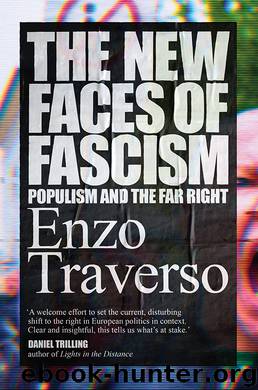The New Faces of Fascism by Enzo Traverso

Author:Enzo Traverso
Language: eng
Format: epub
Publisher: Verso Books
The Public Use of History
If we consider the interpretations of fascism from the perspective of their impact on the historical consciousness and collective memory of the countries where they met with their largest reception, we find contrasting landscapes. Mosse renewed the debate and is unanimously recognized as a pioneer in the contemporary historiography. His books accompanied the emergence of the memory of the Holocaust and were received as an irreplaceable contribution to understanding Nazism. His status as a Jewish-German exile avoided ambiguities when he advanced a method of exploring Nazism from within, proceeding with empathy for historical actors. As he declared in an interview just before his death, the Holocaust called into question European culture as a whole. That is why, he added, ‘all my books concern, in a more or less direct way, the Jewish tragedy of my time.’95
On the other hand, Mosse’s defence of the anti-antifascist campaign waged by De Felice and his disciples was not so benign. In Italy, the renewal of interpretations of fascism coincided with the crisis of antifascism as an ethical and political paradigm. The spread of studies on the cultural and symbolic dimension of fascism accompanied its de-politicization as an object of memory. Sheltered by the neopositivistic claim of a ‘scientific’ and ‘depoliticized’ interpretation of fascism (hugely supported by the political right and the media), Italy finally ‘reconciled’ with its own past. The frontier between understanding and legitimization became more and more uncertain. Fascist liturgy was inscribed into the national heritage, while antifascism was rejected as the politics of a simple minority.
In this way, fascism came to embody national memory, while antifascism (which experienced a new impulse as a mass movement after 8 September 1943) came to be regarded as the product of ‘the death of the fatherland’.96 Fascist violence was erased, obliterating its genocidal dimension in Africa and forgetting its complicity with Nazi politics and the extermination of the Jews.97 Salò’s violence was separated from the history of fascism and inscribed into the civil war of 1943–45,98 now being explained as a reaction to antifascist violence (alternatively characterised as totalitarian, communist, or anti-patriotic). In Italy, De Felice reconciled Mosse with Nolte.99 This was the context for the reception of Gentile’s work. Despite its originality, his investigation of fascist culture seems just as unilateral as the old antifascist one he tried to overcome. Exploring fascism’s self-representations is not sufficient to understand it, just as it is not enough to reduce it to the image spread by its enemies. As his critics observed, Gentile’s method of favouring the ‘literality’ of fascist discourse often led to ‘no longer seeing the difference which exists between things and words’ and identifying the society with the regime and the latter with its external façade.100
Sternhell’s works had a very different impact in France, where they disrupted the old myth of the ‘non-existence’ of French fascism and reopened the debate on the nature of Vichy’s regime.101 Until the mid-1970s, René Rémond’s theory of the ‘non-existence’ of French fascism had legitimized the forgetting of Vichy.
Download
This site does not store any files on its server. We only index and link to content provided by other sites. Please contact the content providers to delete copyright contents if any and email us, we'll remove relevant links or contents immediately.
| Anarchism | Communism & Socialism |
| Conservatism & Liberalism | Democracy |
| Fascism | Libertarianism |
| Nationalism | Radicalism |
| Utopian |
The Secret History by Donna Tartt(18188)
The Social Justice Warrior Handbook by Lisa De Pasquale(11957)
Thirteen Reasons Why by Jay Asher(8461)
This Is How You Lose Her by Junot Diaz(6451)
Weapons of Math Destruction by Cathy O'Neil(5842)
Zero to One by Peter Thiel(5498)
Beartown by Fredrik Backman(5369)
The Myth of the Strong Leader by Archie Brown(5243)
The Fire Next Time by James Baldwin(5024)
How Democracies Die by Steven Levitsky & Daniel Ziblatt(4966)
Promise Me, Dad by Joe Biden(4911)
Stone's Rules by Roger Stone(4866)
100 Deadly Skills by Clint Emerson(4695)
A Higher Loyalty: Truth, Lies, and Leadership by James Comey(4556)
Rise and Kill First by Ronen Bergman(4548)
Secrecy World by Jake Bernstein(4393)
The David Icke Guide to the Global Conspiracy (and how to end it) by David Icke(4386)
The Farm by Tom Rob Smith(4329)
The Doomsday Machine by Daniel Ellsberg(4250)
